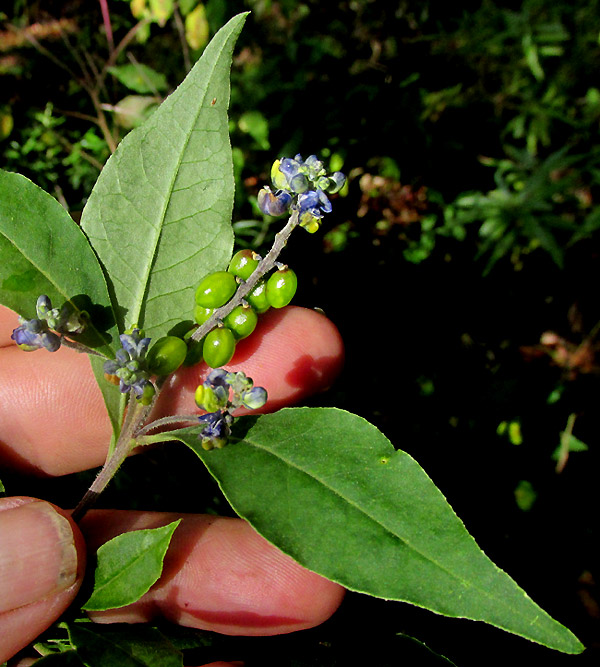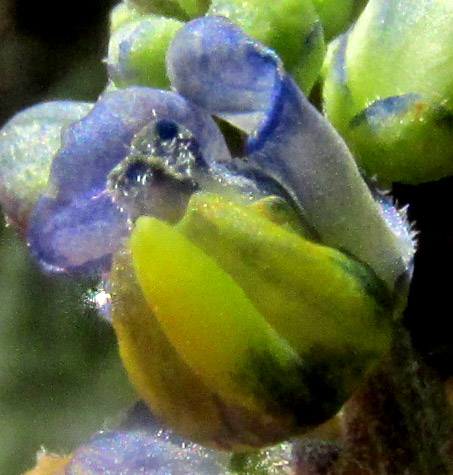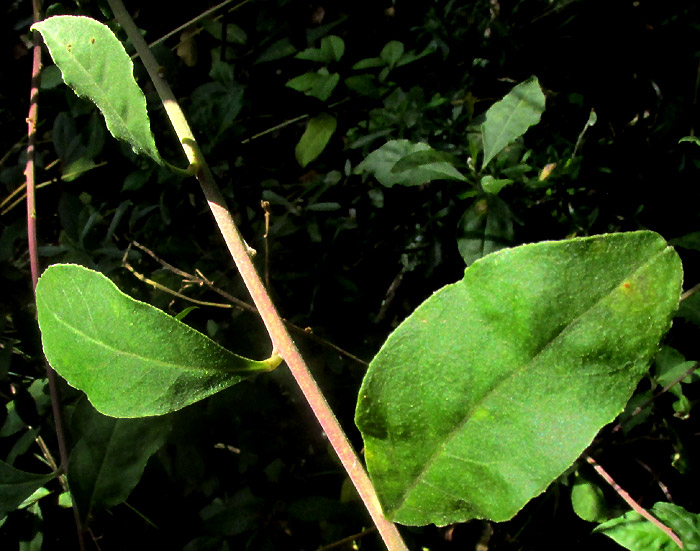Excerpts from Jim Conrad's
Naturalist Newsletter
Entry dated November 10, 2023, from notes taken from ridge with secondary oak forest about 300m west of Cascadas de La Piedad waterfall 3kms NW of the community of San Pablo, municipality of Almeaco de Bonfil; N20.1002°, W100.0067°, elevation 2360 meters (7750ft); extreme southern Querétaro state, MÉXICO
MONNINA CILIOLATA

On a steep, usually shaded slope of an eroded ravine, during this ongoing two-year-long drought, the only flowers to be seen were at the stem tip shown above. Note that the green, immature fruits are of the same size, with no intermediate sizes below the flowers.

As seen above in the image's top, right corner, the flowers displayed bilateral symmetry, with the lower formed into a scoop-shaped "keel," with blue parts appearing above and at the sides. This is similar to a typical bean flower, but different. Such pudgy, short-keeled blossoms almost like those of Bean-Family species point us toward the closely related Milkwort Family, the Polygalaceae. As such, the keel comprises the corolla's lower three fused petals. On the flower's side, there's a large, blue, petal-like sepal, the "wing." The flower bears 6-8 stamens, the pollen-producing anthers of which appear above as blue, fish-egg-like clusters at the top, left of the yellow keel. On both sides of the keel top, arising from the anther clusters, are two blue, shoe-horn-like side petals. Here's another shot of a flower as seen from below.

The leaves were simple ones, occurring singly at stem nodes:

Long, stiff stem branches branched off much thicker, somewhat woody stems, which originated from inside a dense tangle of vegetation.

The Milkwort Family is a medium-size one occurring nearly worldwide; currently it embraces about 27 genera and approximately 900 known species. In this part of highland central Mexico, only two genera are represented, of which the commonly encountered one is the milkwort genus itself, Polygala. When the above flowers were first seen, that's what I assumed we had here. However, Polygala species produce dry (not fleshy), capsular-type fruits which normally split open when mature, such as those seen on the Eggleaf Milkwort up in Texas. The above fruits were fleshy drupes.
Here we have the other Milkwort Family genus found in this area, Monnina. Though maybe 150-200 Monnina species are documented worldwide, in this part of highland central Mexico, there's just one, and that's MONNINA CILIOLATA.
Monnina ciliolata, with no English name, is endemic just to Mexico, occurring in various highland forest types from about the west-central state of Nayarit south through this area to a bit south of Mexico City, in Morelos state.
Commonly used Spanish names for Monnina ciliolata include teñidora and tintórea, both meaning "dyer." A Facebook page entitled "El Tocuz" shows us a sheet of textile dyed a rich blue color using our plant's fruits. An online, undated webpage entitled Plantas de Santa Elena, profiling plants of a conservation area in the state of Hidalgo known as Rancho Santa Elena, tells us that in their area our plant is boiled in water used to bathe "niños asustados," or frightened children.